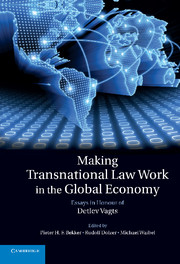Book contents
- Frontmatter
- Contents
- List of contributors
- Foreword: the transnationalism of Detlev Vagts
- List of cases cited
- List of abbreviations and acronyms
- Introduction: a Festschrift to celebrate Detlev Vagts' contributions to transnational law
- 1 Detlev Vagts and the Harvard Law School
- 2 Constructing and developing transnational law: the contribution of Detlev Vagts
- I International law in general
- II Transnational economic law
- III Transnational lawyering and dispute resolution
- 23 Diffusion of law: the International Court of Justice as a court of transnational justice
- 24 Regulating counsel conduct before international arbitral tribunals
- 25 International arbitrators as equity judges
- 26 Customary international law, Congress and the courts: origins of the later-in-time rule
- 27 Mediation and civil justice: a public–private partnership?
- 28 The borders of bias: rectitude in international arbitration
- 29 Managing conflicts between rulings of the World Trade Organization and regional trade tribunals: reflections on the Brazil – Tyres case
- 30 Cross-border bankruptcy as a model for the regulation of international attorneys
- Bibliography of Detlev Vagts
- Index
23 - Diffusion of law: the International Court of Justice as a court of transnational justice
from III - Transnational lawyering and dispute resolution
Published online by Cambridge University Press: 17 November 2010
- Frontmatter
- Contents
- List of contributors
- Foreword: the transnationalism of Detlev Vagts
- List of cases cited
- List of abbreviations and acronyms
- Introduction: a Festschrift to celebrate Detlev Vagts' contributions to transnational law
- 1 Detlev Vagts and the Harvard Law School
- 2 Constructing and developing transnational law: the contribution of Detlev Vagts
- I International law in general
- II Transnational economic law
- III Transnational lawyering and dispute resolution
- 23 Diffusion of law: the International Court of Justice as a court of transnational justice
- 24 Regulating counsel conduct before international arbitral tribunals
- 25 International arbitrators as equity judges
- 26 Customary international law, Congress and the courts: origins of the later-in-time rule
- 27 Mediation and civil justice: a public–private partnership?
- 28 The borders of bias: rectitude in international arbitration
- 29 Managing conflicts between rulings of the World Trade Organization and regional trade tribunals: reflections on the Brazil – Tyres case
- 30 Cross-border bankruptcy as a model for the regulation of international attorneys
- Bibliography of Detlev Vagts
- Index
Summary
Introduction
This chapter highlights aspects of the process of diffusion of law as derived from the law and practice of the International Court of Justice (ICJ), the principal judicial organ of the United Nations seated at The Hague in The Netherlands. The ICJ is the world's only court having general jurisdiction over disputes between sovereign States. Diffusion of law is inherent in the concept of transnational law, which likewise is informed by interaction between legal systems and legal traditions. As understood here, legal diffusion essentially is a transnational phenomenon. This chapter seeks to increase our understanding of this phenomenon by focusing on the ICJ. Our focus on the ICJ in illustrating how legal diffusion occurs on the international plane comports with the goal to give ‘increased attention to public international law and institutions’ advocated by the casebook on Transnational Legal Problems for which Detlev Vagts has served as primary author/editor. According to that seminal work, the domain of transnational law is formed by international law and institutions together with aspects of national legal systems concerning ‘matters foreign’. As such, these constituent elements form ‘the legal framework bearing on relationships among nations or among their citizens and business entities’. Nations, citizens and businesses are all affected by the ICJ's work and they play various roles in it, as described below.
- Type
- Chapter
- Information
- Making Transnational Law Work in the Global EconomyEssays in Honour of Detlev Vagts, pp. 471 - 487Publisher: Cambridge University PressPrint publication year: 2010



